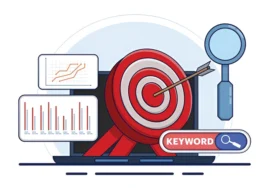
On-Page SEO: Establishing Your Website
In the competitive landscape of online marketing, search engine optimization (SEO) is pivotal in ensuring your website’s visibility. While off-page SEO strategies like link building and social media engagement are essential, finding your website’s success lies in on-page SEO. This comprehensive guide will delve into the key elements of on-page SEO, providing actionable tips to optimize your website for search engines and drive organic traffic.
Understanding On-Page SEO
On-page SEO refers to the optimization techniques applied to your website’s content and structure. It aims to improve your website’s relevance and authority in the eyes of search engines. By implementing effective on-page SEO strategies, you can enhance your website’s ranking in search results and attract more targeted organic traffic.
Key Elements of On-Page SEO
- Keyword Research and Optimization
- Find Relevant Keywords: Conduct thorough keyword research to discover the terms and phrases that your target audience is searching for. Use tools like Google Keyword Planner, Sem Rush, and Ah Refs to find high-volume, low-competition keywords.
- Keyword Placement: Incorporate your target keywords throughout your website’s content, including titles, headings, meta descriptions, URLs, and body text. Avoid keyword stuffing, as it can impact your rankings.
- Keyword Density: keep a balanced keyword density to make sure your content is relevant and informative. Aim for a keyword density of 1-2% within your body text.
- High-Quality Content
- Create Valuable Content: Produce high-quality, informative, and engaging content that addresses your target audience’s needs and interests.
- Optimize Content Length: While there is no definitive rule for content length, I aim to create comprehensive and detailed content that provides value to your readers.
- Content Structure: Use clear headings and subheadings to improve readability and make your content easier to scan.
- Meta Tags
- Title Tags: Craft compelling title tags that describe your page’s content and include your target keywords.
- Meta Descriptions: Write concise and informative meta descriptions that entice users to click on your search results.
- Header Tags: Use header tags (H1, H2, H3, etc.) to structure your content and highlight important sections.
- URL Structure
- Keyword-Rich URLs: Create clean and descriptive URLs that include your target keywords.
- Use Hyphens: Separate words in your URLs with hyphens for better readability and SEO.
- Avoid Dynamic URLs: Opt for static URLs.
- Image Optimization
- Use Descriptive File Names: Name your images with relevant keywords to improve their visibility in search results.
- Alt Text: Add descriptive alt text to your images to give context for impaired users and search engines.
- Optimize Image Size: Compress your images to reduce file size and improve page loading speed.
- Mobile Friendliness
- Responsive Design: make sure your website is responsive and adapts to different screen sizes.
- Mobile-Optimized Content: Give a seamless mobile experience by optimizing your content and layout for smaller screens.
- Page Loading Speed
- Optimize Images: Compress images to reduce file size.
- Minify CSS and JavaScript: decrease the size of your CSS and JavaScript files.
- Leverage Caching: Use browser caching to store static resources locally.
- Reduce Server Response Time: Optimize your server configuration for faster response times.
- Internal Linking
- Interlink Pages: Link to relevant pages within your website to improve navigation and distribute link equity.
- Use Anchor Text: Use descriptive anchor text that includes your target keywords when linking to internal pages.
Advanced On-Page SEO Techniques
While the foundational elements of on-page SEO are essential, several advanced techniques can further enhance your website’s visibility and rankings. Let’s explore some of these strategies:
1. Schema Markup
- Rich Snippets: Implement schema markup to provide search engines with additional context about your content, such as product ratings, event dates, or article authorship. This can result in rich snippets appearing in search results, making your listings more visually appealing and informative.
- Enhanced Visibility: Schema markup can improve your click-through rate (CTR) and increase your chances of appearing in featured snippets.
2. Local SEO Optimization
- NAP Consistency: Ensure your Name, Address, and Phone number (NAP) information is consistent across all online listings, including your website, Google My Business, and social media profiles.
- Google My Business: Optimize your Google My Business profile with accurate information, high-quality images, and positive reviews.
- Local Citations: Build citations by creating listings on local directories and business websites.
3. User Experience (UX) Optimization
- Mobile-First Indexing: Design your website with a mobile-first approach to cater to the growing number of mobile users.
- Page Speed: Continuously monitor and optimize your website’s page loading speed to provide a positive user experience.
- User-Friendly Navigation: Create a clear and intuitive navigation structure that helps users easily find the information they are looking for.
4. Technical SEO
- XML Sitemap: Submit an XML sitemap to search engines to help them crawl and index your website’s pages efficiently.
- Robots.txt: Use a robots.txt file to instruct search engines on which pages to crawl and which to avoid.
- HTTPS: Implement HTTPS to secure your website and improve user trust.
5. Content Marketing
- Quality Content: Create high-quality, informative, and shareable content that resonates with your target audience.
- Content Promotion: Utilize social media, email marketing, and other channels to promote your content and reach a wider audience.
- Backlinks: Build high-quality backlinks from reputable websites to improve your website’s authority and rankings.
Conclusion
On-page SEO is a multifaceted discipline that requires a holistic approach. By combining the foundational elements with advanced techniques, you can significantly improve your website’s visibility and attract more targeted organic traffic. Remember, on-page SEO is an ongoing process that requires continuous monitoring, analysis, and optimization. By staying updated with the latest trends and best practices, you can ensure your website remains competitive in the ever-evolving digital landscape.





